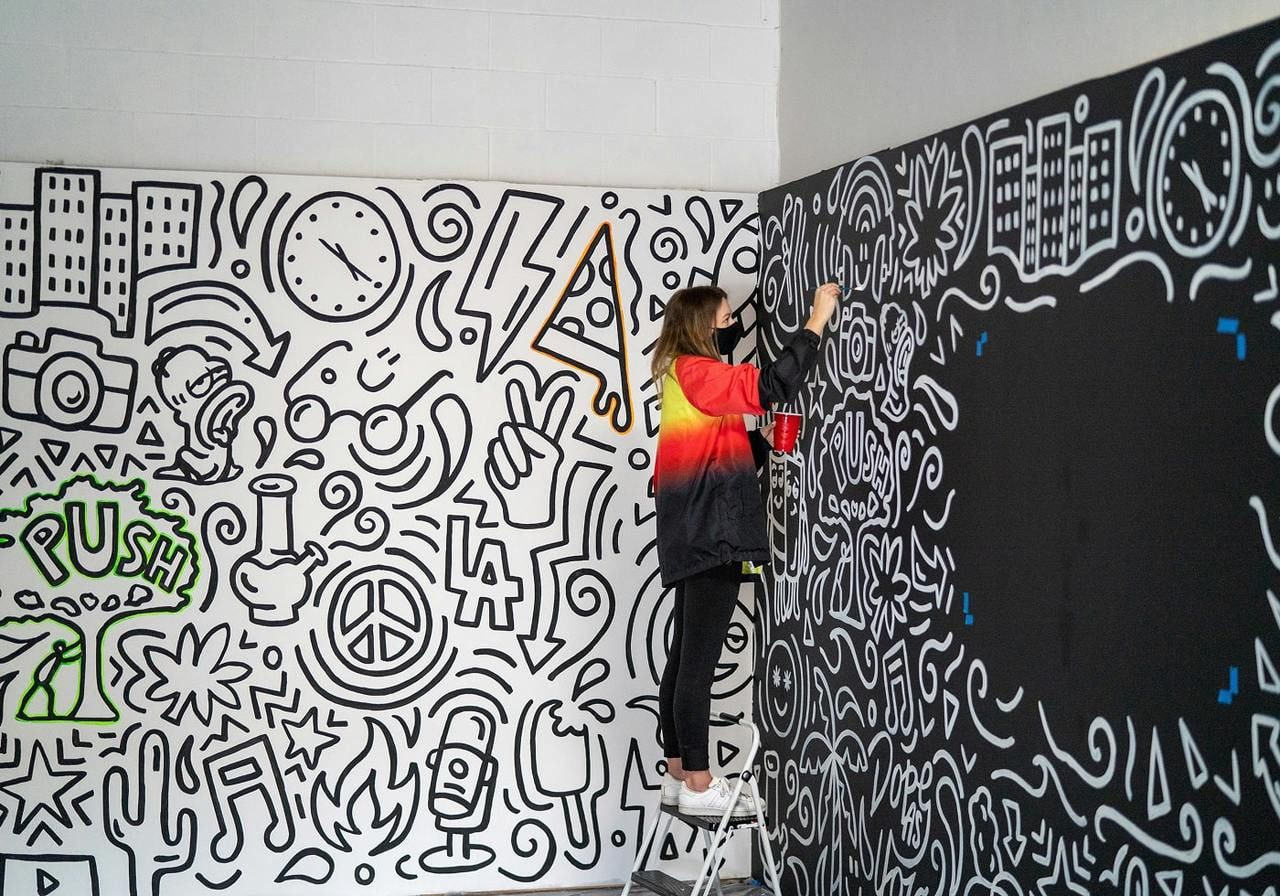Table of contents
Say goodbye to the starving artist stereotype and hello to a thriving creative career! In this guide, we’ll show you how to make money as an artist – from teaching art online and selling prints across the globe to licensing designs for passive income and exploring exciting new outlets that turn your talent into repeatable earnings.
10 Ways to make money as an artist
1. Sell original art and art prints

One of the most classic – and still highly profitable – ways to make money from your work is by selling original art and art prints. You can take the traditional route through art galleries and art fairs, or sell directly at events, markets, or your own website.
-
Online platforms like Etsy, Saatchi Art, and Artfinder make it easy to connect with buyers worldwide.
Want a budget-friendly way to expand your reach? Offer limited-edition art prints of your best pieces. They’re more affordable for buyers while still delivering healthy profit margins. With a print-on-demand partner like Printful, you can upload your artwork, choose wall art products, and list online. When an order comes in, Printful prints, packages, and ships directly to your customer.
The benefits? Steady sales potential, global reach, and the chance to sell one design over and over without constantly producing new originals.
How to start?
-
Photograph or scan your artwork in high resolution.
-
Set up an Etsy shop or Shopify store.
-
List the products and promote them to attract sales.
Valuable reads: How to sell art online and make money as an artist, and How to start an Etsy shop as a beginner.
2. Sell custom products with your art design

Want to see your art on t-shirts, mugs, greeting cards, or phone cases – without stocking a single box of inventory? Welcome to the magic of Print on Demand (POD).
Platforms like Printful and Printify let you upload your designs, choose from a wide product range (think wall art, hoodies, tote bags, and more), and sell through your own website or marketplaces like Etsy and Amazon.
Here’s how it works:
-
Sign up with a POD platform.
-
Pick products to feature your art.
-
Upload your designs and create mockups.
-
Connect your store (Shopify, Etsy, Amazon, etc.).
-
When orders roll in, the POD company prints and ships for you.
Why it’s amazing: No upfront costs, no storage headaches, and a nearly endless product scope. This business model lets you focus on making art and growing your brand while someone else handles the heavy lifting.
Valuable read: How to start a print-on-demand business.
3. Teach art

Teaching is one of the best ways how to make money as an artist online and in person. It lets you share your skills with fellow artists and new students, whether through group sessions, private lessons, or structured courses.
Additionally, run workshops in local shops or community centers, or even host live online classes on Zoom.
-
Start by deciding your niche: Painting, digital illustration, sketches, pottery – whatever your art world specialty is.
-
Next, plan lessons and gather materials. Use AI tools to create a course structure, gather insights, and help you plan the sessions.
Platforms like Skillshare, Teachable, and Udemy make it easy to host your online courses. To promote in-person sessions, use community bulletin boards or social media.
Being an art teacher builds authority and a following while bringing in consistent income. Plus, every class is a chance to create more art and connect with people who love what you do.
4. License your art
Think of art licensing as renting your creativity. Instead of selling your original art pieces, you grant companies permission to use your work on their products – from t-shirts and stationery to home decor and digital products.
You keep ownership, and they pay you a royalty each time your design sells.
Here’s how it works:
-
Create a portfolio of your best, most versatile designs.
-
Research brands that fit your style.
-
Pitch your work directly, or join agencies like Art Licensing International or Wild Apple.
-
Negotiate terms (royalties are usually a percentage of each sale).
The benefits? Passive income, wider exposure, and partnerships that put your art in front of new audiences without you lifting a paintbrush after the initial design. Perfect if you want to earn while focusing on creating more good art.
5. Create an online presence
With so many other artists competing for attention, a solid online presence is your megaphone. Think of it as building your personal art hub – a space where buyers and fans connect with you, discover your work, and make purchases.
-
Start an art blog to share tips and behind-the-scenes stories.
-
Launch a YouTube channel with tutorials or process videos.
-
Or build a strong social media presence on Instagram, TikTok, and Pinterest.
How?
-
Choose 1-2 social media platforms you enjoy (consistency is easier when you like the format).
-
Share a mix of finished pieces, works-in-progress, and personal stories to connect with your audience.
-
Collaborate with other artists through joint lives, art challenges, or cross-promotions.
-
Link everything back to your store so your fans can buy your work instantly.
The best part? It grows your audience beyond your local circle, helps you connect with art buyers globally, and positions you as a go-to creative person in your niche. Done right, it turns casual scrollers into loyal customers.
Valuable read: How to make a profitable YouTube channel.
6. Sell digital products with your art

Selling digital products is like planting money seeds – you create once and watch sales sprout repeatedly. For artists, this could mean stock illustrations, digital wallpapers, printable coloring pages, art-inspired planners, or even brush sets for Procreate and Photoshop.
How to make it happen:
-
Decide on a product that aligns with your style and audience.
-
Create polished, high-resolution files (remember, good art still matters in the digital space).
-
Sell them through your website, or on an online marketplace like Creative Market, Gumroad, or Etsy.
-
Keep products relevant: Seasonal packs, themed bundles, and special releases keep your shop buzzing.
Why it’s gold for artists: No shipping, no packaging, no physical inventory. Delivery is instant, meaning buyers anywhere can purchase and download immediately.
For many artists, it’s the easiest way to earn extra income while freeing up time for art classes, new projects, and marketing tactics.
7. Enter art contests and apply for grants
Art contests aren’t just for bragging rights – they can amp up your visibility, connect you with industry pros, and score you some serious prize money.
National and international competitions like the Luxembourg Art Prize, BP Portrait Award, or World Illustration Awards welcome submissions from all skill levels. Many also include online exhibitions, which allow your work to be seen by a global audience in the art world.
-
How to find them: Websites like ArtDeadline.com, CallForEntries.com, and even Instagram hashtags like #artcontest regularly post opportunities.
Applying for grants: If you need financial support for a project or to cover expenses, look into grant programs from organizations like the Pollock-Krasner Foundation or National Endowment for the Arts. The application process usually involves submitting a portfolio, project proposal, and artist statement.
Pro tip: Always read the guidelines carefully and tailor your application to the contest or grant’s mission. Winning (or even being shortlisted) can open doors to exhibitions, press coverage, and collaborations.
8. Write and publish art-related content
If you love creating and talking about art, writing is a powerful way to grow your influence and income. Write and self-publish art books on your techniques, create a blog with tutorials, or dive into art history topics that fascinate you.
Where to publish:
-
Launch your own blog using WordPress or Squarespace.
-
Pitch articles to blogging platforms like Medium, Colossal, or My Modern Met.
-
Self-publish books through Amazon KDP or Blurb.
This positions you as an authority in the art business, attracts students or clients, and opens the door to more collaborations. And because your written work lives online, it can keep bringing in money over time.
Pro tip: Repurpose your content – a blog post can become a YouTube video, while a chapter of an art book can be adapted into social media posts to draw in readers.
9. Collaborate with other artists
Teaming up with other artists can take your work further than going solo. You might co-create a limited-edition print series, host a joint exhibition, or launch co-branded merchandise like apparel, wall art, or prints.
Collaborations are especially useful for expanding into each other’s audiences, which means more followers, more buyers, and ultimately more money.
Where to find collabs:
-
Join local art collectives or co-working spaces.
-
Network on Instagram or in Facebook artist groups.
-
Attend art fairs or residencies to meet creatives with similar styles or values.
Once you’ve found your creative partner, set clear goals, timelines, and revenue-sharing agreements so the project runs smoothly. Collaboration doesn’t just double your reach – it can also make creating art more inspiring.
10. Work online as a freelance creative
One of the best ways how to make money as a digital artist is by working with online clients. From brand collaborations to commissions, the internet has turned the art business into a global playing field. You could design graphics for companies, illustrate for magazines, or create animations for marketing campaigns.
Where to find clients:
-
Direct outreach to brands whose style matches yours.
For corporate or editorial gigs, tailor your portfolio to show you can meet professional standards while still injecting personality.
The beauty of working online is flexibility – create art for clients anywhere in the world, build long-term partnerships, and keep plenty of time for making art on your own terms.
Done right, this path can deliver both steady work and room for creative growth.


Tips for making money with art

Turn your creativity into a business model
If you want to shift from hobbyist to art business owner, start by getting crystal clear on your target audience – who they are, what they buy, and where they spend time.
Here’s how:
-
Run surveys using Google Forms or Typeform. Ask questions about art styles they like, price points, and preferred products.
-
Use analytics tools like Instagram Insights, Pinterest Analytics, or Google Analytics to see who’s engaging with your content (age, location, interests).
-
Study other artists in your niche by checking their Etsy reviews, product descriptions, and social media comments to see what customers love most.
-
Price strategically by browsing similar products on marketplaces like Etsy, Saatchi Art, or Society6, then setting your price to match your desired positioning (premium, mid-range, or budget-friendly).
Tip: Draft a simple business plan so you have a roadmap for pricing, marketing, and growth.
Create a professional foundation for success
As an independent artist, how you present yourself matters as much as your work. A polished, organized approach makes art buyers and gallery directors take you seriously.
Here’s how:
-
Build a clean portfolio using Canva, Adobe, or a site builder like Squarespace. Include high-quality images, dimensions, prices, and short descriptions for each piece.
-
Invest in quality art supplies from trusted brands (Winsor & Newton, Faber-Castell, Blick) so your work maintains a consistent standard.
-
Refine your art skills by joining workshops at local art centers or taking online classes on platforms like Skillshare or Coursera.
-
Keep up your art practice with a set weekly schedule. Even a daily 30-minute sketch session keeps you sharp.
Pro tip: Always have a short, professional bio and artist statement ready to send to galleries, media, or collaborators – it speeds up opportunities.
Build multiple income streams
Combining different income types creates financial stability and can lead to financial freedom.
Here’s how:
-
Pick 3-4 streams that complement each other. For example, sell prints on Etsy or your own site, teach classes on Skillshare or Teachable, and run a print-on-demand store selling your art on custom products.
-
Cross-promote. Mention your classes in your shop listings, link your POD products in your YouTube descriptions, and send all traffic to your mailing list.
-
Track results with Google Sheets or Airtable so you know which stream is making the most money – and which needs a boost.
Example combo: An artist selling watercolor art prints online could also teach a beginner course and license designs for home decor.
How to make money selling art? Partner with Printful!
Print on Demand is your fast track to turning designs into products without touching a single shipping box.
With Printful, you get in-house printing, a massive product catalog (think apparel, accessories, posters, pet products, toys, games, and a lot more), and 24/7 support – all wrapped in a smooth and professional manner.
-
Create a free account – no hidden fees, no subscription.
-
Upload your artwork to the Design Maker and tweak until perfection.
-
Integrate your store (Shopify, Etsy, WooCommerce, you name it) and list your products online.
When someone buys, Printful handles printing, packing, and shipping. This setup can deliver decent income or even grow into a full-time income, all while keeping you free to dream up your next big art project.
How to make money as an artist: FAQ
Artists earn money by selling originals and prints, teaching classes, licensing designs, offering commissions, and creating digital products. To start, build an online portfolio, set up a shop with Shopify or Etsy, promote on social media, and explore print-on-demand platforms like Printful to add scalable income streams.
Profitability comes from pricing correctly and diversifying income streams. Research similar artists’ pricing on Etsy or Saatchi Art, factor in material and time costs, then add your profit margin. Combine sales with teaching, licensing, and POD to create steady revenue that covers expenses and funds your hobby.
Artists combining strong marketing with scalable products tend to earn more. Examples include illustrators selling prints and licensing designs, digital artists selling digital products worldwide, and painters offering high-end originals plus affordable reproductions.
Home decor and digital art tend to sell best. Big, eye-catching pieces make walls happy, while digital downloads keep earning without extra work. You can reach decor lovers and online shoppers at the same time, creating a steady flow of sales from one creative idea.
Yes – and it’s faster than ever. Create an online store with Shopify or Etsy, upload high-quality photos, and optimize listings with keywords buyers search. Pair this with POD services like Printful to sell globally without managing stock, turning your designs into reliable income streams.
Final thoughts
The art world is brimming with opportunities for creative entrepreneurs ready to turn passion into profit. From selling prints to teaching online and launching digital products, you can build income that lasts. Ready to start? Sign up with Printful today, put your designs on products, and watch your art reach customers worldwide.



By Baiba Blain
With 7+ years of experience in translation and creative writing, Baiba now leads a squad of talented writers, balancing research-backed storytelling with team guidance, quality assurance, and SEO processes. Outside of work, she enjoys exploring old castles, spontaneous road trips, and talking back to her cats. 10/10 arguments won so far.





